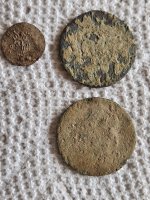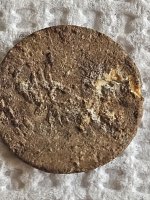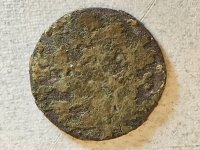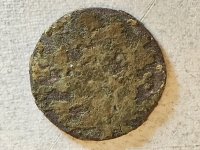Navigation
Install the app
How to install the app on iOS
Follow along with the video below to see how to install our site as a web app on your home screen.
Note: This feature may not be available in some browsers.
More options
You are using an out of date browser. It may not display this or other websites correctly.
You should upgrade or use an alternative browser.
You should upgrade or use an alternative browser.
Found these coins yesterday I think the two larger ones are too corroded to identify, the other little I found about 8 inches from these two
- Thread starter kmk
- Start date
- Oct 26, 2004
- 24,720
- 24,648
- 🏆 Honorable Mentions:
- 2
- Detector(s) used
- Minelab Explorer
- Primary Interest:
- Shipwrecks
If they were mine, I'd start with a toothbrush and water and see if more features become exposed.
Don in SoCal
Don in SoCal
Last edited:
- Aug 19, 2014
- 38,272
- 139,072
- Detector(s) used
- JW 8X-ML X2-VP 585
- Primary Interest:
- All Treasure Hunting
Wire wheel ? ? ? (Just kidding.)
Short of serious electro bath or equiv .... i think your going to be guessing awhile.
Short of serious electro bath or equiv .... i think your going to be guessing awhile.
- Feb 9, 2020
- 7,142
- 13,750
- Detector(s) used
- XP Deus
Minelab E-Trac
- Primary Interest:
- Metal Detecting
Very nice !
If they were mine I'd try "Andre Pencils" first - then Electrolysis.
Good luck with the ID's - keep us posted !
If they were mine I'd try "Andre Pencils" first - then Electrolysis.
Good luck with the ID's - keep us posted !
Almy
Bronze Member
I suspect there is enough detail beneath the corrosion to be able to ID them. Various possibilities for treatment have been suggested to you. I agree that if they were mine, I would start with more mechanical cleaning and resort to chemical treatment if that did not work. Each step is irreversible but the coins are worthless until they are identified anyway. Once you know what they are, they might reveal something about history and it is just good to know what they are and especially the dates. They'll not be worth money, of course.
Chilli
Bronze Member
A little not well known trick I use for nuggets, coins or whatever is to get a coffee mug and 1/3 fill with water, put it in the microwave oven for around 4 minutes. The water will be nuclear hot and looks like its fizzing!Already did that.
Stand back and drop the coin or whatever into it. I say stand back because when the cold item hits that water it goes crazy. You'd be surprised what can come off of some items when you do it. Sometimes it really can shift some stuff that a brush can't, some things its so solid not much happens. But it is my go to for lots of items that are dirty and I don't want to use chemicals or abrasives.
Caliche
Greenie
Thanks for the boiling water and flashlight tips, vinegar isn't doing anything to the reddish, hard crust on clad coins from my local playground.
Bucket Lister
Bronze Member
- Dec 20, 2023
- 1,237
- 2,280
- Detector(s) used
- XP Dēus II
XP MI-6
XP WSA II-XL
- Primary Interest:
- Metal Detecting
I'm more fascinated by the smaller item. 🤓
It seems to have at least some detail, so hopefully a better chance of identifying it.
FWIW, what detail there is looks like maybe feathers/wings(?)
IDT it's American (unless it's a token I'm unfamiliar with), BICBW.
It seems to have at least some detail, so hopefully a better chance of identifying it.
FWIW, what detail there is looks like maybe feathers/wings(?)
IDT it's American (unless it's a token I'm unfamiliar with), BICBW.
pa-dirt_nc-sand
Silver Member
The small piece looks like play money, aluminum from the 1940 -50’s. The 2 large coppers I would do the hot peroxide method. Heat up 1/2 cup peroxide to almost boiling, drop in coins, remove and vigorously toothbrush or scotch brite pad until enough of the corrosion comes off. Then rinse in water and a light coating of nose grease.
kmk
Jr. Member
- Feb 4, 2016
- 80
- 453
- Detector(s) used
- AT PRO and APEX
- Primary Interest:
- All Treasure Hunting
- Thread starter
- #15
When I get back today I will have the time to start cleaning them. As for the little one I thought play money at first, but it rings right at 81 on my AT Pro, the same as the trime and the 2 x 1/2 reals I have, found, plus the signal does not waiver at all just like the other small silver coins I have found. Give me a few days to try some of the methods that have been suggested, and I let everyone know.The small piece looks like play money, aluminum from the 1940 -50’s. The 2 large coppers I would do the hot peroxide method. Heat up 1/2 cup peroxide to almost boiling, drop in coins, remove and vigorously toothbrush or scotch brite pad until enough of the corrosion comes off. Then rinse in water and a light coating of nose grease.
Ask a local Jeweler to ultrasonic them for 5-10 min. As a Jeweler I've done it hundreds of times!
(only for the extremely corroded ones!)
grasshopper
Bronze Member
- Aug 13, 2007
- 1,867
- 2,858
- 🥇 Banner finds
- 1
- Detector(s) used
- XP Deus/Deus 2
- Primary Interest:
- All Treasure Hunting
The one is definitely play money...i knew it looked familiar when you first posted it.


Play Money - Japan One Dime - SKU-F6671 | eBay
Find many great new & used options and get the best deals for Play Money - Japan One Dime - SKU-F6671 at the best online prices at eBay! Free shipping for many products!
ebay.com
As an eBay Associate we earn from qualifying purchases.
kmk
Jr. Member
- Feb 4, 2016
- 80
- 453
- Detector(s) used
- AT PRO and APEX
- Primary Interest:
- All Treasure Hunting
- Thread starter
- #19
I cleaned them both up with super hot water trick someone had suggested. One of the big ones was far too gone after that. The other one you can almost manage out a shield like a New Jersey Copper, but who knows for certain. As for the little coin you are spot on as far as it being play money. You can clearly see "one" and then the flip side "money". I have screwed up so many coppers by trying to get the corrosion off, I am a little gun shy cleaning really anything too much. But thank you, and all the others who have given me advice on these coins and the ones I have had questions about in the past!!!!The one is definitely play money...i knew it looked familiar when you first posted it.

Play Money - Japan One Dime - SKU-F6671 | eBay
Find many great new & used options and get the best deals for Play Money - Japan One Dime - SKU-F6671 at the best online prices at eBay! Free shipping for many products!ebay.com
As an eBay Associate we earn from qualifying purchases.
Almy
Bronze Member
The way I look at it with bad coppers is that I cannot ID them in their bad condition so they are totally worthless. If I try a strong cleaning method, the worst that can happen is that they remain worthless. For me, over half the time, I get an ID and a date range. Then I have some useful data for my historical interest. I've used lemon juice for some and fine sandpaper on a flat surface for others. But those are just my simple methods. Other methods, such as suggested here, may give better results.
Top Member Reactions
-
 3440
3440 -
 2012
2012 -
 1949
1949 -
 1156
1156 -
 1101
1101 -
 909
909 -
 807
807 -
 801
801 -
 798
798 -
 788
788 -
 746
746 -
 532
532 -
 477
477 -
 475
475 -
 445
445 -
 422
422 -
 416
416 -
 416
416 -
E
415
-
 390
390
Users who are viewing this thread
Total: 2 (members: 0, guests: 2)










